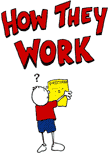 |
|
 |
Using a safety restraint correctly makes a big difference. For example, a child safety seat may not protect your child in a crash if it isn’t used correctly and installed properly in your vehicle. Check To Be Sure That...
All Children age 12 and under are properly restrained in the back seat!!!
A rear-facing child safety seat is never placed in front of an active passenger air bag.

Always read the child safety seat
instruction manual.
Read your vehicle owner’s manual
seat belt and child seat installation section.
Infants, from birth to at least age one, and at least 20 pounds should ride in the back seat in a rear facing safety seat.

Children over one year and at least 20 pounds may ride in a forward facing child safety seat in the back seat. Children should ride in a safety seat with full harness until they weigh about 40 pounds.

The Lower Anchors and Tethers for Children (LATCH) System is designed to make installation of child safety seats easier by requiring child safety seats to be installed without using the vehicle’s seat belt system. As of September, 1999, all new forward facing child safety seats (not including booster seats) meet stricter head protection requirements, which, in most cases, calls for a top tether strap. This adjustable strap is attached to the back of a child safety seat. It has a hook for securing the seat to a tether anchor found either on the rear shelf area of the vehicle or, in the case of mini-vans and station wagons, on the rear floor or the on the back of the rear seat of the vehicle. As of September, 2000, most new cars, minivans, and light trucks have this tether anchor.
 |
As of September 1, 2002, two rear seating positions of all cars, minivans and light trucks are equipped with lower child safety seat anchorage points located between a vehicle’s seat cushion and seat back. Also as of September 1, 2002, all child safety seats have two attachments which will connect to the vehicle’s lower anchorage attachment points. Together, the lower anchors and upper tethers make up the LATCH system. |
All children who have outgrown child safety seats should be properly restrained in booster seats until they are at least 8 years old, unless they are 4'9" tall.
|
Belt
positioning booster must be used with a lap and shoulder
belt |
High-back booster with |
High-back, belt-positioning booster provides head restraint in
vehicle back seats with low backs or no head restraint. Must be used with
a lap and shoulder belt. |
If only a lap belt is available in the rear
seating positions, an option may be to contact the vehicle dealer to see if
retrofit shoulder belts can be installed. Another option may be to install
products which can be used with a lap belt only such as a speciality-made
harness or vest. Contact the Auto Safety Hotline at (888) 327-4236 for
additional information.
Graphics courtesy of: Transportation Safety Training Center, Virginia Commonwealth University